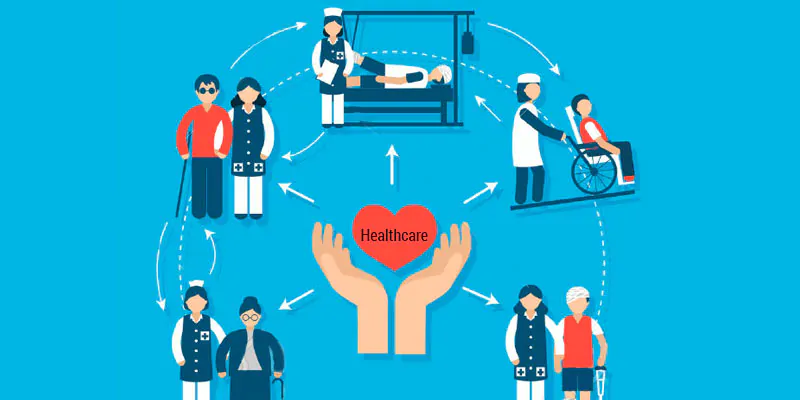The new trend in health care technology has grown after the shifting work rules imposed by dealing with the Coronavirus pandemic, It is likely to continue in 2022 and the coming years. Digital solutions have proven their importance in 2020.
The global Internet of Things market is valued at $50.5 billion. It is expected to grow to $254.2 billion in 2026.
Investments in the Internet of Things and other digital solutions in healthcare are already on the rise, as In 2021, significant technological trends were recorded in the field of hospitalization, in addition to the adoption of new technologies.
To solve the problem of the shortage of medical and nursing staff after the pressure of the Corona pandemic, technology was resorted to or services upon request. These services began to form a separate sector in the world today.

How Has the Healthcare Sector Benefited From Digital Transformation?
Medical researchers say, “No other year will change healthcare like it did in 2020 and 2021, as the global pandemic pushes the health sector to adapt and innovate, also determining how care will change health in the next ten years.
This shift does not mean in any way that the industry has moved significantly from the path it was It is, as digital technologies are already having an impact on healthcare. But investing in change was not so fast as it is currently registered and expected in the future.”
In a follow-up to the developments of the health sector in general, it appears that the healthcare systems that have been under the pressure of the Coronavirus pandemic, it was depending significantly on technology to become more efficient and appropriate to deal with the emerging situation.
This means simplifying inpatient care, relying on telemedicine technologies, and using big data analytics to make informed decisions, and even accept the risks of weak cybersecurity measures.
Based on all this reality and its developments, how did IT teams become an integral part of hospital operations and to what extent will this transformation change the future of medicine in the world? Information technology companies have come a long way in developing cybersecurity and artificial intelligence applications and innovate more solutions.
The trends of the healthcare technology market and the urgent need for advanced digital solutions reflect a significant increase in investment on this level. It was recently shown that global healthcare financing has set a record in 2020, and is on track to achieve an equal or higher number by the end of 2021.
Last year, there were more than 5,500 deals totaling $80.6 billion in equity financing.
Funding for digital health companies reached $26.5 billion in 2020, and this is the highest level it has reached at all.
Technology-based healthcare was the most funded in 2020. Health sector experts believe that healthcare technology can bring great value and make a significant impact on future digital health trends.
Employment in Healthcare Industry

The COVID-19 pandemic has exposed a number of operational gaps in the global healthcare system, for example, That some work teams have to be wider or narrower, or work differently to achieve greater efficiency and better results in terms of dealing with crises. With these gaps in many parts of the world, employment issues will extend far beyond the pandemic.
The World Health Organization estimates that there will be a shortage of 9.9 million healthcare workers worldwide world level by 2030.
For example, the United States will need to hire 2.3 million new healthcare workers by 2025, to take care of older Americans, according to a report by Mercer, a global advisory for healthcare professionals.
Under these circumstances, it is not surprising that healthcare job advertisements remain open for months or even months for years.
This is especially true in rural areas, even in North America and Europe where healthcare facilities were unable to find enough physicians and nurses to meet the demands of the crisis.
Therefore, the concept of demand-based nursing or when needed has become more common with the lack of nursing professionals.
For example, GapNurse is a successful digital solution to such problems, which is an online recruitment platform for healthcare professionals.
Due to its success and importance, it has been developed and seamlessly connects independent professional nurses and nurse assistants with care facilities that are looking to fulfill short-term and permanent jobs.
Their leadership team consists of operators and owners of home care companies, nursing homes, skilled nursing, with additional extensive experience in the planning, treatment, and management of chronic, acute, and post-acute care.
Nurses are tested for their background before they are hired to participate in these assignments.
So facilities can rest assured that they are receiving the best quality care professionals. Once they pass the experience exam, nurses choose tasks that fit their schedule and comfort level as nurses.
Such digital solutions promote lower patient care costs and increase same-day pay and access to online learning and continuing education tools.
On-Demand Services & Shared Economy

The other thing imposed by the Coronavirus pandemic and the development of the path of medical care, is what has become known as the on-demand economy What does this have to do with healthcare trends and their future?
Technology companies created the “on-demand economy” to meet consumer demand for goods and services.
It is clear that this business model has grown, driven by developments in the field of communication and increased focus on Personal devices. It is also referred to as the “access economy” or the “shared economy”.
This transformation has completely changed the perception of the medical and healthcare industry.
This development is in the not-too-distant future, whether in terms of creating new jobs, or adopting more efficient methods And less cost to the patient and hospital.
For example, an independent workforce was created, which faced a talent shortage in many services according to the demand. Recruitment is now seen as an on-demand service rather than traditional permanent employment.
This has provided highly skilled workers with an alternative to full-time work. This is what helped the growth of the hospitalization and investment sectors together.
In North America and Europe, there are more than 150 million “independent contractors” as of the year 2020. It found that 81 % of Americans would like to turn a “side business” or “part-time” into a career. More than 50 % of those surveyed are self-employed to earn extra money.
Today, it is noted that this phenomenon has spread in the world of hospitalization, and its achievement of positive results encouraged more expansion.
Digital solutions such as US-based Wendy seem to be practical and beneficial to the healthcare sector. This private, on-demand, digital service provides caregivers of older adults with a click of a button.
There are other similar services that have introduced a new type of work to the health and hospital sector. Observers are waiting for this development to receive more support and approval.
It is well established that telemedicine will represent the simplest form of on-demand service in the list of trends in healthcare technology. While it used to be a good option since 2020 it has become is necessary.
In the early days of pandemic restrictions, patients with chronic health problems – diabetes and high Blood pressure, high cholesterol, etc. – stay away from hospitals.
This has delayed the care they needed, and the care that could have been provided by adopting telemedicine and remote monitoring medical devices.
The European Agency for Safety and Health at Work says that most online platforms have used a “growth strategy first and ask compliance questions later.”
The main trends of healthcare technology are clearly related to the digitization and use of healthcare data. These are examples of the technological trends in healthcare that we are likely to see in the next few years.
Securing Healthcare Technology with Cybersecurity

With this development, the issue of cybersecurity remains to protect these applications and ensure their effectiveness and the continuity of their services.
For example, Pfizer, BioNTech, and the European Medicines Agency have all reported attacks targeting vaccine data.
Quite a few hospitals in the US and Europe have fallen victim to healthcare cyber-attacks and data breaches, which has prompted the healthcare sector to become more aware of the cybersecurity infrastructure.
For its part, Carbon Black, a cybersecurity company, found that there were 239.4 million attack attempts against Healthcare customers in the year 2020.
Its Healthcare Security Report recorded “an average of 816 attack attempts per endpoint in 2020 , which is an increase of 9,851 % over 2019.” So it is clear that Cybersecurity and data protection are perhaps the most-watched of all emerging healthcare IT trends In the year 2021.
Multiple hacks and attacks confirmed the need to invest in this sector. Naturally, the push for a digital healthcare industry needs more security infrastructure to protect it.
This means that cybersecurity companies are likely to see an increase in healthcare customers in the year 2021.
In healthcare, big data is likely to be the most important trend in holistic medical technology in this year.
The devices that are part of the Internet of Medical Things (IOMT) will solve at least some of the problems the sector has had Healthcare dealt with in the year 2020.
The Internet of Things could also save money for the healthcare industry. A Goldman Sachs report estimated that the IoT for healthcare could save $300 billion in… Through better ways to practice medicine.
For example, IoMT in healthcare can increase operational efficiency, as in all digital industries, the workflow can be improved and automated. And all of this promises a brighter future for safer patients and less expensive care.






